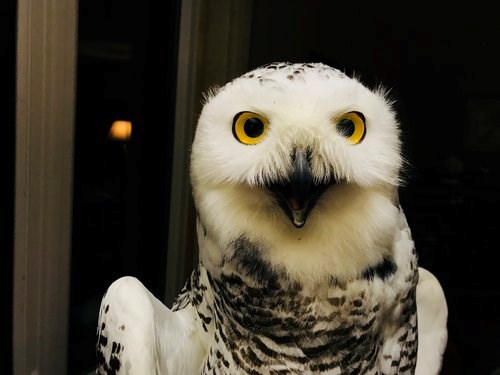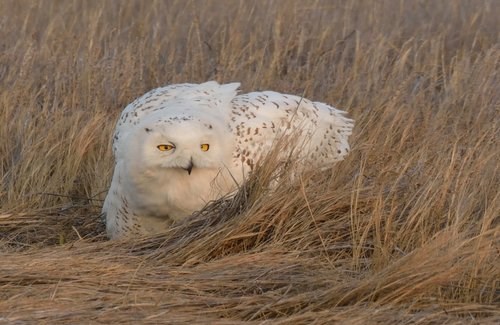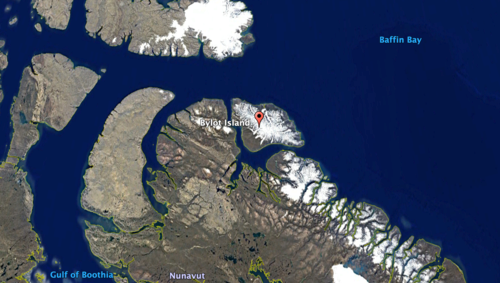Irruptions and Innovation
Posted on in In the Field by Zoey Greenberg, Science Outreach CoordinatorZoey Greenberg, Science Outreach Coordinator

In 2007, Dr. JF Therrien deployed 12 transmitters on snowy owls on Bylot island in the Canadian Arctic. Snowy owls, like other raptors, can be difficult to monitor due to their territoriality and low densities. Arctic-breeding raptors typically establish nesting sites in remote locations, adding to the logistical dilemma of gaining insight into their life history traits, and the role they play within the Arctic ecosystem.
Satellite transmitters, citizen science, and long-term life history studies are extremely valuable tools that allow researchers to examine the movement ecology of birds, including snowy owls. Mixing and matching these tools can open doors to compelling scientific questions, and in the case of Therrien’s snowy owls, has resulted in papers covering a range of topics. New information on survival, reproduction rate, dispersal of adults, irruptions and winter movements are among recent Hawk Mountain publications that were made possible through this type of innovation.
Two such papers were led by former conservation science trainees, in collaboration with others, including Dr. JF Therrien. These papers delved into the mystery of snowy owl irruptions, defined as the “massive movement of individuals over large distances, associated with large fluctuations in food supply.” Some of us have been lucky enough to see a snowy owl in Pennsylvania, on those rare winters when the birds venture further south than usual. I myself drove two hours to catch a glimpse, and I will never forget the sight of that owl hunkered down in the middle of a field, glittering in evening light. As I drove away, I couldn’t help but wonder; what brings them here?
Two primary hypotheses have been proposed to explain irruptions; the “lack-of-food” hypothesis suggests that snowy owls leave their normal wintering grounds because of food shortage in certain years. This implies that the snowy owls we see in Pennsylvania should be in poor shape, and likely close to starving. The alternative “breeding success” hypothesis instead links irruptive movements to a surplus of food on the breeding grounds.

Snowy owls specialize in lemmings, a prey resource that occurs in pulses, due to their population dynamics. One year there may be a plethora of lemmings scurrying around the tundra, the next year very few, due to high predation and other factors. Lots of lemmings means lots of chicks, which means lots more owls. The breeding success hypothesis implies that the reason we see snowies in Pennsylvania is because following a high lemming year, there are so many owls dispersing at the end of the summer that some young birds push south.
To add depth to our knowledge of irruptions, Teja Curk, a conservation trainee from 2016, assessed the body condition (mass relative to size) of snowy owls during both irruptive and “regular” years. Teja assessed body condition of snowies on both regular (Great Plains) and irregular (Northeaster North America) wintering grounds, to see whether the birds we see during irruptive years are, in fact, starving. She found that most owls (male, female, juvenile and adult) were in good shape during irruptive years and even discovered that body condition was better on the bird’s irregular wintering grounds. “Good shape” in this context varies depending on sex and age of the bird, however less than 2% of the owls approached the weight threshold that would deem them a starving bird. Her results provide support for the breeding success hypothesis.
Pablo Santonja and Irene Mestre, trainees from 2015, looked specifically at the age of the birds found south during irruptive years. Their results supported the same hypothesis, showing that the majority of owls (up to 90%) seen in eastern North America are juvenile birds, meaning they are less than 1 year of age. As with some other migratory species, the more dominant birds within a population don’t move as far. Adult snowy owls often out-compete young birds, so it makes sense that in a year where adults are laying up to 11 eggs, some of those young owls will need to leave to avoid competition from more successful, experienced adults.

This leads to an interesting point: perhaps these two competing hypotheses are not, as Teja notes in her paper, mutually exclusive. After a highly productive lemming year, many lemmings will be eaten due to a surge in predator numbers, and therefore the next year could produce low lemming numbers. If this happens, snowy owls could be forced to look elsewhere for food. So, it turns out, that both a surplus of food and a lack of food seem to play a role in the patterns of movement among snowy owl populations.
If you ask me, these papers are a beautiful example of the scientific method at work; formulating ideas, testing those ideas, and polishing the conclusions in pursuit of certainty. Hats off to our trainees and their collaborators for hard work and intriguing findings. Teja is currently at the Max Planck Institute for Ornithology in Germany pursuing a PhD. Pablo is living in Spain, and Irene is now returning from three years in Australia.
Both of these papers utilized a data set resulting from a 25 year-long study in which live snowy owls were weighed, sexed, and aged. Christmas Bird Count (CBC) was also a valuable asset in both studies. For those of you unfamiliar with CBC, every winter thousands of volunteers gather together on the same day, collecting bird records within a territory and submitting them to a database that provides an impressive summary of which birds were seen, where, and how many. These papers demonstrate the utility of both citizen science and long-term studies, and in a rapidly changing world, this cross-pollination of resources is critical. We are very proud of our trainees for their hard work, and grateful to citizen scientists around the globe who give their time to participate in the expansion of our raptor knowledge.
Gaining a holistic understanding of an ecosystem requires acknowledgment of moving parts within, not separate from, the whole. Hawk Mountain’s research is part of several collaborative efforts to better understand the role of snowy owls within the big picture, including Project SNOWstorm and the Bylot Island Ecological Studies and Environmental Monitoring.
Future projects will include building a model that combines reproductive and mortality rates to assess population trends of snowy owls. This past August, three transmitters were deployed on chicks before they left their breeding grounds. Investigating the movement patterns of these birds will hopefully allow for a comparative look at owls throughout the Eastern tundra, Western tundra, and those in between.
Check out Project SNOWstorm’s website (including a blog written by J.F Therrien on the most recently tagged snowy owls in Barrow, Alaska, as well as interactive maps): projectsnowstorm.org/posts/tracking-young-snowies-in-the-arctic/